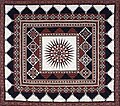
Quilting is the term given to the process of joining a minimum of three layers of fabric together either through stitching manually by hand using a needle and thread, or mechanically with a sewing machine or specialised longarm quilting system. An array of stitches is passed through all layers of the fabric to create a three dimensional padded surface. The three layers are typically referred to as the top fabric or quilt top, batting or insulating material and the backing.
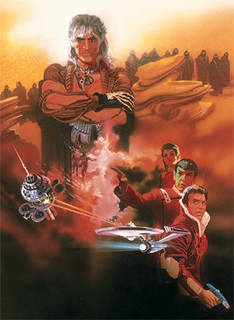
Star Trek II: The Wrath of Khan is a 1982 American science fiction film directed by Nicholas Meyer and based on the television series Star Trek. It is the second film in the Star Trek film series, and is a sequel to Star Trek: The Motion Picture (1979). The plot features Admiral James T. Kirk and the crew of the starship USS Enterprise facing off against the genetically engineered tyrant Khan Noonien Singh, a character who first appeared in the 1967 Star Trek episode "Space Seed". When Khan escapes from a 15-year exile to exact revenge on Kirk, the crew of the Enterprise must stop him from acquiring a powerful terraforming device named Genesis. The film is the beginning of a three-film story arc that continues with the film Star Trek III: The Search for Spock (1984) and concludes with the film Star Trek IV: The Voyage Home (1986).

A quilt is a multi-layered textile, traditionally composed of three layers of fiber: a woven cloth top, a layer of batting or wadding, and a woven back, combined using the technique of quilting, the process of sewing the three layers together. The pattern of stitching can be the key decorative element if a single piece of fabric is used for the top of a quilt, but in many cases the top is pieced from a patchwork of smaller fabric pieces; and the pattern and color of these pieces will be important to the design.

The Victoria and Albert Museum in London is the world's largest museum of applied and decorative arts and design, as well as sculpture, housing a permanent collection of over 2.27 million objects. It was founded in 1852 and named after Queen Victoria and Prince Albert.
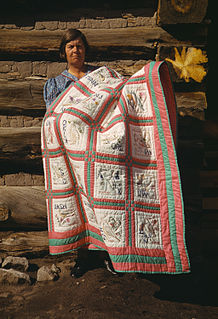
A patchwork quilt is a quilt in which the top layer may consist of pieces of fabric sewn together to form a design. Originally, this was to make full use of leftover scraps of fabric, but now fabric is often bought specially for a specific design. Fabrics are now often sold in quarter meters. A "fat quarter" is one square meter folded into four and cut along the folds, thus giving a relatively square piece of fabric 50 cm on a side, as opposed to buying a quarter of a meter off the roll, resulting in a long thin piece that is only 25 cm wide.
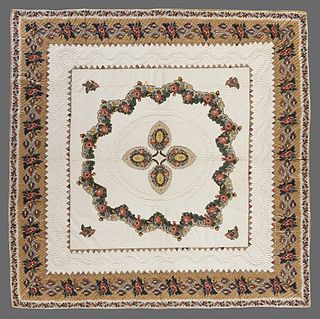
Broderie perse is a style of appliqué which uses printed elements to create a scene on the background fabric. It was most popular in Europe in the 17th century, and probably travelled from India, as there are some earlier findings there. The technique could be considered an early form of puzzle piecing.

Chintz, woodblock printed, painted, stained or glazed calico textiles, originated in Golconda in the 16th century. Cloth is printed with designs featuring flowers and other patterns in different colours, typically on a light plain background.. Since the 19th century the term has also been used for the style of floral decoration developed in those calico textiles, but then used more widely, for example on chintzware pottery and wallpaper. Chintz designs are derived from the style of Indian designs themselves reflecting Mughal art. A white base with floral and animal prints are its basic characteristics.
In film, a redress is the redecoration of an existing movie set so that it can double for another set. This saves the trouble and expenses of constructing a second, new set, though they face the difficulty of doing it so the average viewer does not notice the same set is reused. Also there could be logistical problems, such as conflicting shooting schedules, continuity if the set is not quite the same as it was or different. The latter problem arises because the set dresser may be unaware of changes created by the action.

The history of quilting, the stitching together of layers of padding and fabric, may date back as far as 3400 BCE. For much of its history, quilting was primarily a practical technique to provide physical protection and insulation. However, decorative elements were often also present, and many quilts are now primarily art pieces.
Joachim is a genetically engineered character in the fictional Star Trek universe who appears as one of Khan Noonien Singh's henchmen in the Star Trek episode "Space Seed" and the film Star Trek II: The Wrath of Khan, in which he is played by Mark Tobin and Judson Scott, respectively.
Quilt art, sometimes known as art quilting, mixed media art quilts or fiber art quilts, is an art form that uses both modern and traditional quilting techniques to create art objects. Practitioners of quilt art create it based on their experiences, imagery, and ideas rather than traditional patterns. Quilt art generally has more in common with the fine arts than it does with traditional quilting. This art is generally either wall hung or mounted as sculpture, though exceptions exist.
The Hat and Fragrance Textile Gallery is an exhibit space at Shelburne Museum in Shelburne, Vermont which houses quilts, hatboxes, and various other textiles. The name "Hat and Fragrance" refers both to Electra Havemeyer Webb's collection of hatboxes and to the fragrant, herbal sachets used to preserve textiles. In 1954, Shelburne Museum was the first museum to exhibit quilts as works of art; prior to this exhibition quilts were only shown as accessories in historic houses.

The term Provençal quilting, also known as boutis, refers to the wholecloth quilts done using a stuffing technique traditionally made in the South of France from the 17th century onwards. Boutis is a Provençal word meaning 'stuffing', describing how two layers of fabric are quilted together with stuffing sandwiched between sections of the design, creating a raised effect. The three main forms of the Provençal quilt are matelassage, piqûre de Marseilles, and boutis. These terms, along with trapunto are often debated and confused, but they are all forms of stuffed quilting associated with the region.

Khan Noonien Singh is a fictional antagonist in the Star Trek science fiction franchise. The character first appeared as the major antagonist in the Star Trek: The Original Series episode "Space Seed" (1967), and was portrayed by Ricardo Montalbán, who reprised his role in the 1982 film Star Trek II: The Wrath of Khan. In the 2013 film Star Trek Into Darkness, he is portrayed by Benedict Cumberbatch.

The Tristan Quilt, sometimes called the Tristan and Isolde Quilt or the Guicciardini Quilt, is one of the earliest surviving quilts in the world. Depicting scenes from the story of Tristan and Isolde, an influential romance and tragedy, it was made in Sicily during the second half of the 14th century. There are at least two extant sections of the quilt, one of which is displayed in the Victoria and Albert Museum's Medieval and Renaissance Galleries, and the other in the Bargello in Florence. A third quilt, also depicting Tristan and Isolde, but not thought to be part of the V&A and Bargello examples, is held in private hands. The Tristan Quilts are the only known surviving examples of medieval quilts.
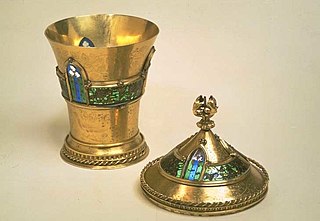
Plique-à-jour is a vitreous enamelling technique where the enamel is applied in cells, similar to cloisonné, but with no backing in the final product, so light can shine through the transparent or translucent enamel. It is in effect a miniature version of stained-glass and is considered very challenging technically: high time consumption, with a high failure rate. The technique is similar to that of cloisonné, but using a temporary backing that after firing is dissolved by acid or rubbed away. A different technique relies solely on surface tension, for smaller areas. In Japan the technique is known as shotai-jippo, and is found from the 19th century on.

Corded quilting is a decorative quilting technique popular from the late 17th through the early 19th centuries. In corded quilting, a fine fabric, sometimes colored silk but more often white linen or cotton, is backed with a loosely woven fabric. Floral or other motifs are outlined in parallel rows of running stitches or backstitches to form channels, and soft cotton cord is inserted through the backing fabric using a blunt needle and drawn along the quilted channels to produce a raised effect. Tiny quilting stitches in closely spaced rows fill the motifs and provide contrast to the corded outlines.

Pastiglia[paˈstiʎʎa], an Italian term meaning "pastework", is low relief decoration, normally modelled in gesso or white lead, applied to build up a surface that may then be gilded or painted, or left plain. The technique was used in a variety of ways in Italy during the Renaissance. The term is mostly found in English applied to gilded work on picture frames or small pieces of furniture such as wooden caskets and cassoni, and also on areas of panel paintings, but there is some divergence as to the meaning of the term between these specialisms.
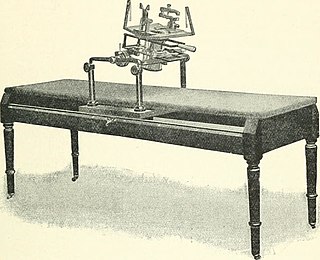
The radiography of cultural objects is the use of radiography to understand intrinsic details about objects. Most commonly this involves X-rays of paintings to reveal underdrawing, pentimenti alterations in the course of painting or by later restorers, and sometimes previous paintings on the support. Many pigments such as lead white show well in radiographs.
Cecelia Tapplette Pedescleaux, also known as Cely, is an African-American quilter of traditional and art quilts, inspired by historians, other African-American quilters, and quilt designs used during the Underground Railroad to communicate messages to slaves seeking freedom. Her quilts have been shown in China, France, Washington, D.C., New Orleans, and in other locations in the United States. A solo show of 75 of her quilts were shown at the Le Musée de Free People of Color in New Orleans (2013–2014).
















